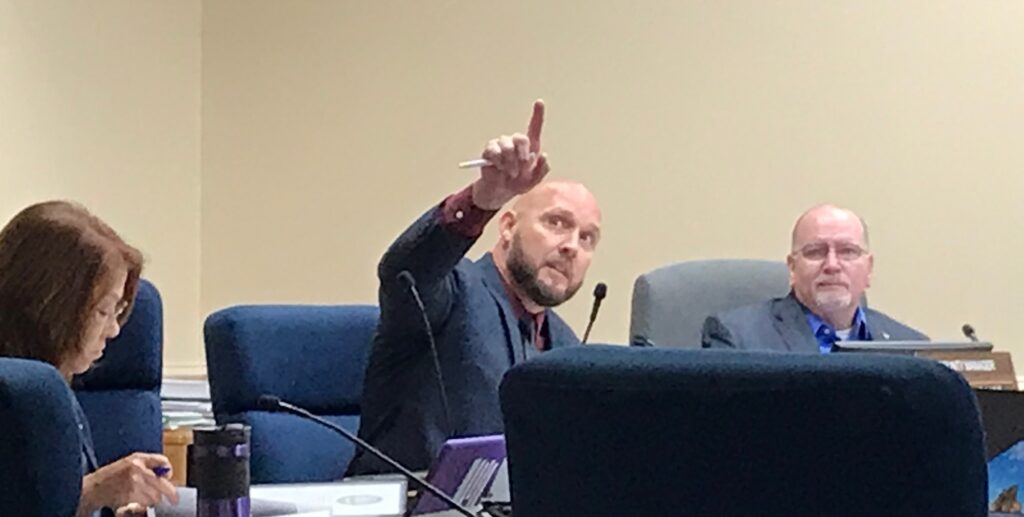By Cindy Jackson
Reporter
August 23, 2021

At the most recent meeting of the Nassau County Board of County Commissioners two public hearings were scheduled relating to the proposed County budget for Fiscal Year 2021-2022.
The dates are September 13 and September 27, 2021, and both hearings will be held at 96135 Nassau Place in Yulee, Florida, beginning at 6PM.
In addition to setting the public hearings, it was the FY21-22 budget that dominated the discussion at the BOCC meeting of August 18.
Assistant County Manager Marshall Eyerman made the official presentation and later provided more detail via email in which he explained “Responding to opinions and options expressed at the August 16, 2021 workshop and other meetings held earlier in the year, County staff made adjustments and presented to the BOCC another modified draft budget.”

Eyerman went on to explain, “During the last two weeks the Board of County Commissioners have been reviewing each line item of the budget and through that review they recommended the reduction of certain line items (printing, office supplies, misc. supplies, dues/subscriptions, utility, communication, other) which resulted in $585,850 being identified for potential reallocation.”
It was the sum of $585,850 that was the focus of much of the BOCC discussion on August 18th with the consensus reached to use that money for expanded health insurance benefits for County employees, additional monies to three area non-profits, and the remainder dedicated to making improvements in Spring Lake Estates, a residential community of approximately 150 homes in Callahan.
Said Commissioner Klynt Farmer, who represents District 5 (which includes Callahan), “this is long overdue.” Fixing the drainage issues in Spring Lake Estates is expected to improve the situation as well at Bismarck Road which often floods.
The County’s Reserve Funds were also a topic of much discussion. There are “minimums and maximums” for each reserve fund. The “minimums” are set typically by the Board of County Commissioners and the maximums are often governed by State statute.
The County’s major Reserve Funds are as follows:
Reserve for Contingency (generally used to cover unbudgeted expenditures or overruns)
Reserve Fund Balance (typically two months of the County’s operating budget)
Reserve for Emergencies (for things like hurricanes and COVID)
Reserve for Economic Uncertainty
(Includes payments promised but not yet paid as
part of economic development incentives, like Lignotech)
Reserve for Fleet/Equipment (used for equipment and County fleet needs)
Reserve for Capital Projects (typically already committed through the CIP (Capital Improvement Project) process)
In 2016 and 2017, Nassau County was impacted heavily by Hurricanes Irma and Matthew, resulting in expenditures of approximately $7.1 million. Only $6.7 million (or 94%) was reimbursed by the Federal Emergency Management Agency (FEMA) but that didn’t happen for close to two years.
In 2020, the County met the COVID-19 pandemic head on and spent some $15 million most of which was reimbursed through the federal CARES (“Coronavirus Aid, Relief, and Economic Security”) Act program, in fairly short order and promptly “deposited” back into the Emergency Reserve fund.
A bit of “back and forth” took place between Commissioner John Martin and County Manager Taco Pope as to the reason and rationale for the number of reserve funds outlined in the proposed budget, with Pope emphasizing that all is done at the direction of the BOCC . . . under “fiscal policies that have been in existence since 2006.”
Commissioner Martin then pushed Mr. Eyerman asking if other jurisdictions have as many reserve funds as does Nassau County to which Assistant County Manager Eyerman responded, “yes.” Eyerman explained that historical events often dictate the amounts the County ultimately decides to dedicate to reserves but also often takes recommendations as made by the Government Finance Officers Association (GFOA).
After much “banter” between the Commissioners and staff, at the end of an almost two-hour meeting, the Board unanimously agreed to provide:
$400,000 for the Road and Bridge training program currently being developed with the Union. (Studies well document that investing in employees’ training and retention is much less expensive that constant recruitment).
To allocate the $585,850 in identified “savings” in this way:
- $250,000 to employee health insurance
- $253,000 to Spring Lake Estates for drainage improvements
- $25,000 to the Council on Aging
- $20,000 to Barnabas
- $33,200 to Starting Point and
and to transfer $698,350 from the Contingency Reserve to the Emergency Reserve Fund.
At one point, Commissioner Martin said: “I don’t think many (if any) previous boards have looked at this stuff in detail the way we have.”
A memo from County staff to BOCC members (distributed earlier in the week) said:
“The budget is a blueprint to services and planned projects/improvements to be carried out in the county. Holding workshops for the Board and citizens allows for increased transparency, discussions and contributes to the overall planning and implementation of the adopted budget.”
The County’s fiscal year begins on October 1, 2021.
For more information on the FY21-22 budget, go https://www.nassaucountyfl.com/168/Management-Budget where to download reports and presentations and to watch the meeting in its entirety, go to https://www.nassauclerk.com/watch-meetings/
